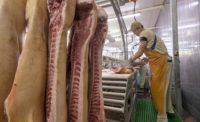Beef industry must take control of own food-safety destiny

In the past two decades, we have Implemented mandatory HACCP programs, developed a list of best practices and devoted considerable resources to research in pre- and post-harvest areas. Add to those advances the aggressive post-harvest intervention programs we’ve implemented and we’ve made significant progress in the “War on Pathogens.”
But has it been enough? Do we have systems in place to provide evidence on a routine basis regarding the effectiveness of our interventions?
The meat industry must ask if we have aggressively implemented the “Best Practices” we’ve developed and if we effectively are dealing with regulators and consumer groups. Are we using the best available science and technology to produce safer beef? From an image standpoint, are we pulling together as an industry to make certain that we are speaking with one voice? As an industry, do we strive to implement strong food-safety programs from the ranch to the table?
Do we pull together as an industry and as a scientific community to make certain that regulatory policy is based on strong science? Do we have the resources from state, federal and industry sources to support the development of new knowledge and science?
Unfortunately, the answer to the above questions is NO!
It’s time!
It’s time for the beef industry to aggressively take the lead on the food-safety agenda. No more finger-pointing up and down the food chain, no more allowing USDA policies to be implemented based on flawed or no science and no more major recalls/illnesses because we did not do enough.
It’s time to demonstrate the effectiveness of the systems we currently have in place. Does available data validate our current interventions? Are they working as well as we think?
It’s time to speak with one voice — let the world know that the U.S. beef industry is serious about producing safe beef. It’s time to let solid, validated science influence industry actions. It’s time to spread the strong beef safety program message throughout the food chain. It’s time to commit the necessary resources to get the job done.
How?
- Step I — Industry leaders (major companies, associations, etc.) must agree that they want to make this happen. They must be ready to take their food-safety programs to the next level.
- Step II — We must demonstrate that current systems used by the industry are effective. Industry should contract with third parties to collect new data and evaluate existing data to determine the effectiveness of current innovations and interventions.
- Step III — We must develop a food-safety plan; a roadmap for the beef industry. A small group of experts should be tasked to develop a “Strategic Plan” with specific goals and action steps that will become the beef industry’s food-safety agenda. The plan should focus on validated, peer-reviewed science that can be used today and should determine the direction research should pursue for the future. The plan should also address needed changes in current procedures for key issues.
- Step IV — We must plant for implementation of the new food-safety plan. There should be strong agreement among beef industry leaders that this plan will be embraced and implemented. This agreement and the plan should be widely communicated, and its implementation should be aggressive.
- Step V — More food-safety science should be identified, validated, commercially developed and used. Industry should make significant resources available to support the development of new science and processes. A group, selected by the industry, should continually research new science. Rigorous peer-review and validation should be performed to ensure scientific effectiveness. If it works and impacts the safety of the product, it should be exposed to the beef industry as quickly as possible.
- Step VI — Industry leadership should devise effective mechanisms to interface with FSIS, other USDA regulators, and Congress regarding their plan and what the science says. The beef industry must present a strong and consistent message. The beef industry is weakest when the government and the consumer groups are able to divide and conquer.
Much of what is outlined here is not new, but it is time to implement and move to the next level! It is time to speak with one strong voice. It is time to win the debate with strong science. We do not know what this Administration or this Congress will bring, but if we sit and wait, it will be too late to influence the agenda with strong science.
If there has ever been a time when the beef industry needs to put their differences aside and pull together, it is now! It does not matter who gets the credit. What matters is producing the safest beef in the world. It’s time!
Looking for a reprint of this article?
From high-res PDFs to custom plaques, order your copy today!








